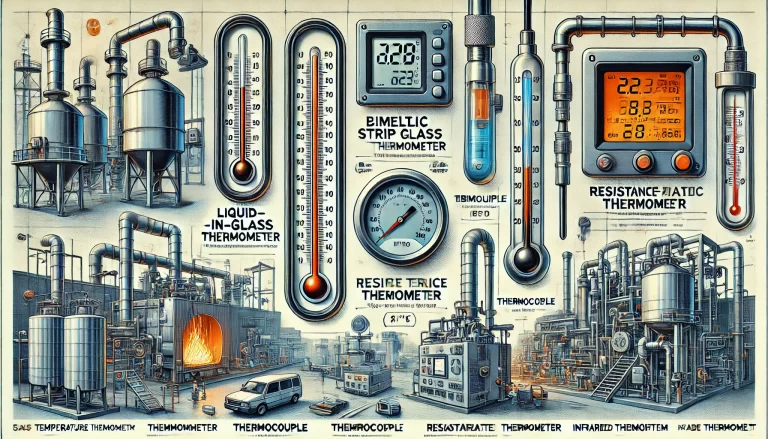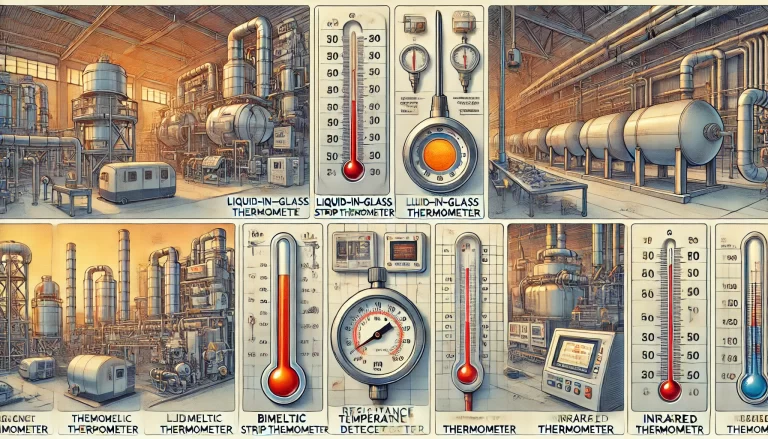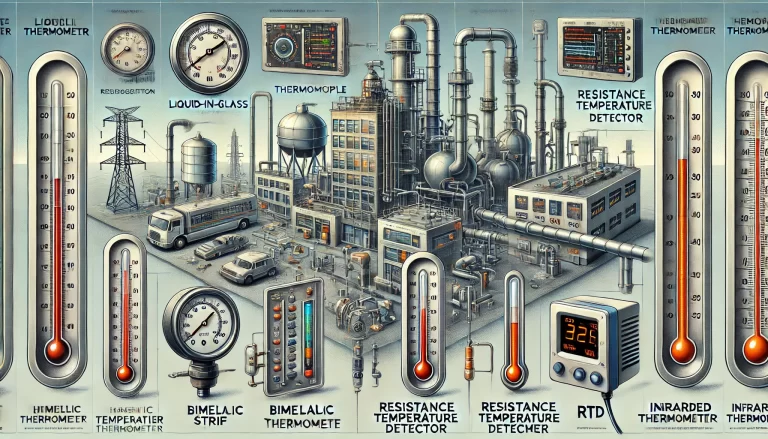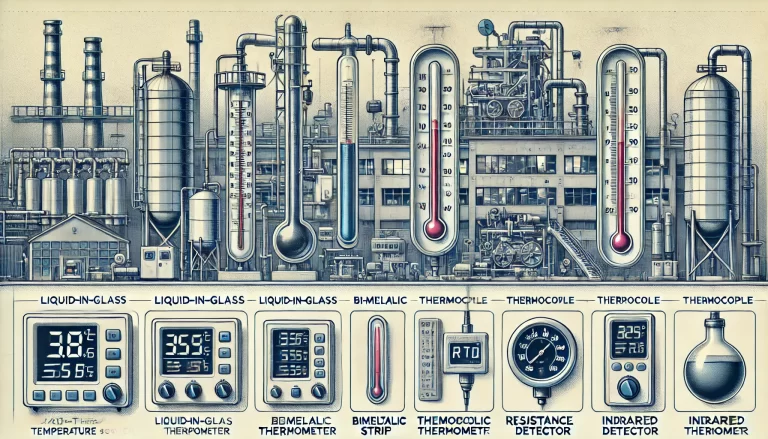Temperature measurement is crucial across various industries, from manufacturing to healthcare, to ensure safe and efficient operations. Industrial thermometers come in different types, each suited to specific environments and applications. These thermometers vary in design, materials, and measurement methods. Below is a detailed exploration of the most commonly used industrial thermometers and their applications.

1. Liquid-in-Glass Thermometers
Principle of Operation:
Liquid-in-glass thermometers, commonly filled with mercury or alcohol, operate based on the principle of thermal expansion. As the temperature rises, the liquid inside the thermometer expands and rises in the tube. The level of the liquid corresponds to the temperature scale printed on the glass.
Applications:
These thermometers are typically used for low- to moderate-temperature measurement in non-industrial settings such as laboratories, refrigeration systems, and food processing plants. Due to the limited temperature range and fragility of the glass, their industrial use is somewhat restricted. However, they remain popular in settings where extreme precision is not required.
Temperature Range:
Mercury thermometers can measure temperatures between -39°C to 350°C, while alcohol-based thermometers are useful for lower temperature ranges, typically from -100°C to 70°C.
2. Bimetallic Strip Thermometers
Principle of Operation:
A bimetallic thermometer consists of two strips of different metals, bonded together, which expand at different rates when heated. The resulting deformation (bending) of the strip is proportional to the temperature, which is then mechanically displayed on a dial.
Applications:
These thermometers are widely used in HVAC systems, boilers, pipelines, and industrial equipment where robust and simple temperature measurement is required. They are particularly valued for their durability and ability to withstand harsh environments.
Temperature Range:
Bimetallic thermometers typically measure temperatures ranging from -50°C to 500°C, making them suitable for a wide variety of applications.

3. Thermocouples
Principle of Operation:
Thermocouples are based on the thermoelectric effect, where a voltage is generated when two different metals are joined together and exposed to heat. The voltage generated is directly related to the temperature at the junction of the two metals.
Applications:
Thermocouples are the most commonly used thermometers in industrial settings due to their wide temperature range, cost-effectiveness, and fast response times. They are ideal for high-temperature environments, including furnaces, turbines, heat exchangers, and kilns. Thermocouples are often used in industries such as metal processing, chemical manufacturing, and power generation.
Temperature Range:
Depending on the type of thermocouple (Type K, J, T, etc.), the temperature range can be anywhere from -200°C to 1700°C.
4. Resistance Temperature Detectors (RTDs)
Principle of Operation:
RTDs measure temperature based on the principle that the electrical resistance of metals like platinum increases linearly with temperature. RTDs are known for their accuracy and repeatability, making them ideal for precise temperature measurements.
Applications:
RTDs are often used in industries requiring high-precision measurements, such as pharmaceuticals, food processing, and petrochemicals. They are also commonly found in laboratory settings and industrial processes where tight control of temperature is necessary. RTDs are more stable and accurate than thermocouples but are usually more expensive.
Temperature Range:
RTDs can measure temperatures ranging from -200°C to 600°C. Platinum-based RTDs (Pt100, Pt1000) are especially common due to their stability and accuracy.
5. Infrared Thermometers
Principle of Operation:
Infrared thermometers measure temperature by detecting the infrared radiation emitted by an object. These thermometers use a lens to focus the infrared light onto a detector, which converts it to an electric signal and displays the temperature reading.
Applications:
Infrared thermometers are ideal for measuring temperatures in situations where contact methods are impractical, such as moving objects, hazardous surfaces, or locations where sterility is required. They are commonly used in industries like steel manufacturing, HVAC, and food safety.
Temperature Range:
Infrared thermometers can measure a wide range, typically from -50°C to 3000°C, depending on the design and intended application.

6. Gas-Expansion Thermometers
Principle of Operation:
In a gas-expansion thermometer, temperature measurement is based on the expansion of a gas confined in a bulb. The pressure generated by the gas expansion is proportional to the temperature and is displayed on a calibrated scale.
Applications:
Gas-expansion thermometers are particularly suited for high-temperature applications in industrial processes like steel manufacturing or high-temperature chemical reactions. They are durable and can measure temperatures accurately in harsh environments.
Temperature Range:
These thermometers generally cover a wide temperature range, often from -100°C to 800°C, depending on the gas used and the design of the thermometer.
7. Thermistor Thermometers
Principle of Operation:
Thermistors are made from semiconductor materials whose resistance decreases significantly with increasing temperature. This change in resistance is measured and converted to a temperature reading.
Applications:
Thermistors are typically used in applications where precise temperature control is essential, such as medical equipment, electronics cooling systems, and environmental monitoring systems. They are highly sensitive to small changes in temperature but are limited to lower temperature ranges compared to other industrial thermometers.
Temperature Range:
The typical temperature range for thermistors is -100°C to 300°C, making them suitable for low- to moderate-temperature applications.

Choosing the Right Thermometer for Industrial Applications
The selection of a suitable industrial thermometer depends on several factors, including:
- Temperature range: The thermometer should be capable of accurately measuring the required temperature range.
- Environment: Consider whether the environment involves high temperatures, corrosive materials, or difficult-to-access locations.
- Accuracy and precision: Different applications may require varying levels of precision. For example, food processing and pharmaceuticals require highly accurate measurements, whereas rough estimates may suffice for HVAC systems.
- Response time: Fast response times are critical in applications like metal processing or machinery monitoring.
- Durability: Some thermometers, like bimetallic and thermocouples, are robust enough to withstand harsh industrial environments, while others may be more fragile.
Conclusion
Industrial thermometers play a crucial role in maintaining safe and efficient operations across industries. From high-precision RTDs used in pharmaceutical manufacturing to the robust thermocouples found in furnaces, each type has its unique advantages and is tailored to specific applications. Understanding the principles of operation and the conditions where each thermometer type excels can help in selecting the right tool for the job.
